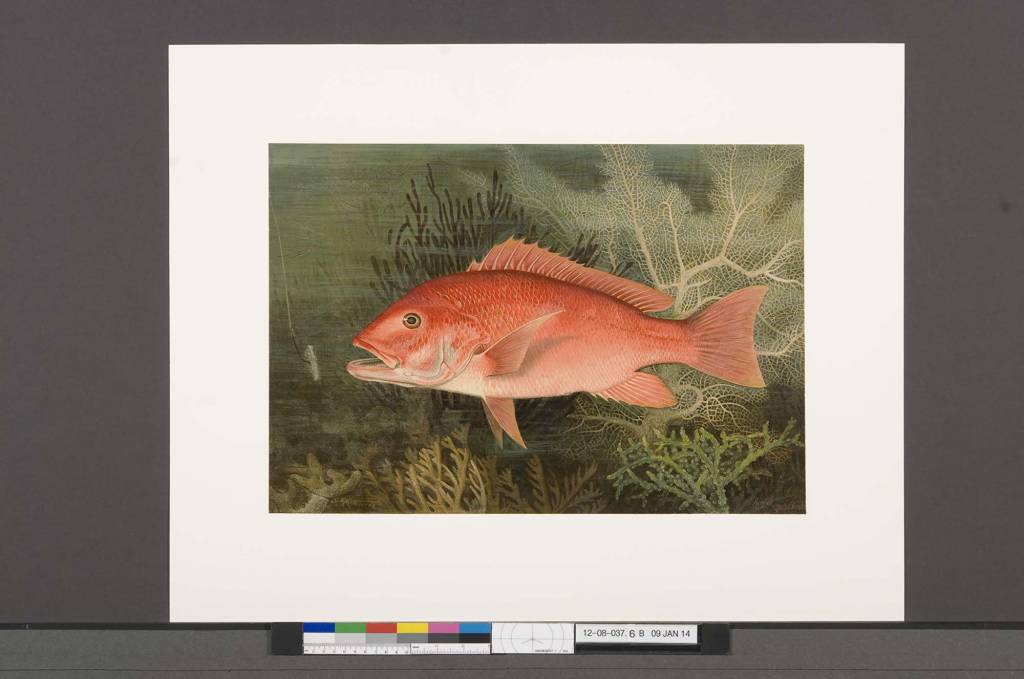Fish Stories is a temporary exhibition featuring 20 color prints from Game Fishes of the United States, 1879 -1880, illustrated by Samuel A. Kilbourne (1836-1881), which is in the collection of the Crystal Bridges Library. The exhibition is on view through September 21.
When I first discovered Game Fishes of the United States among the Library’s rare collection of nineteenth-century American color plate books, I marveled at how as a body of work they convey the drama of sport fishing that is so popular in the beautiful lakes and rivers of Arkansas. I thought: what fun it would be to exhibit the prints for all of the anglers who visit our “Natural State” every spring and summer! However, although the chromolithographs beautifully capture a number of distinctly American fishes in their natural surroundings, including the striped bass, sheepshead, bluefish, weakfish, red snapper, pompano, and brook trout, the prints were very much in need of repair—the fish needed cleaning!
And so it began in August of 2012. I contacted Heugh-Edmondson Conservation in Kansas City to take a look at each of the 20 fish prints. It was a full day of learning about paper conservation from Tom and his wife Nancy Heugh (Paper Conservator at the Saint Louis Art Museum), and in the process I got to know Tom and Nancy and Kilbourne’s fish a little better!

Before: September, 2012. Note small tears (circled in white). Click to enlarge.
Samuel Kilbourne, Red Snapper from Game Fishes of the United States (New York: Charles Scribner’s Sons, 1879), 1879 – 1880, Chromolithograph, Crystal Bridges Museum of American Art Library, Bentonville, Arkansas. Photography by Heugh-Edmondson Conservation Services, LLC.
It was obvious the prints needed to be sheared from their mounts. Most of the mounts were torn around the edges, and yellowed and stained with foxing, and they needed to be replaced with new acid-free mounts. Tom shared with me that this process inevitably leaves adhesive material on the backs of the prints that needs to be removed in a very careful, laborious manner. It would take days to clean each of the 20 prints, employing ammoniated de-ionized water to the back of each one, carefully scraping with a honed Casselli spatula, and then finally clearing residue with cotton swabs and de-ionized water. Moreover, this would be followed by local pressing of each print, assuring minimized planar distortions: bunching up, wrinkling, buckling, curling, or folding of the prints.
It is also essential to preserve the surface characteristics of the prints. Tom explained the complicated process to me, sharing how he would need to saturate the clusters of paper fibers with a synthetic resin applied carefully with a brush. Then he would apply moisture to the larger accretions and deposits to continue removing fine fibers with tweezers. At this point, if any of the fish revealed tears, scrapes, or scratches, he would apply careful in-painting with watercolors and gum arabic. But there was more! After the prints were cleaned, Tom would prepare remoistenable Japanese lining papers using methylcellulose paste, humidify the prints, and apply the liners to the backs. Needless to say, this is highly skilled, detailed work, and fascinating to observe!

After: January 2014.
Samuel Kilbourne, Red Snapper from Game Fishes of the United States (New York: Charles Scribner’s Sons, 1879), 1879 – 1880, Chromolithograph, Crystal Bridges Museum of American Art Library, Bentonville, Arkansas. Photography by Heugh-Edmondson Conservation Services, LLC.
The couple catered in Mexican food from an old favorite Kansas City restaurant that afternoon, and along with their lovely assistant Anna, we had a very stimulating conversation. We had mutual friends and long histories in Kansas City, but somehow had never crossed paths. That afternoon would be the start of more great visits with Tom and Nancy, who would very quickly become dear friends, joining my husband and me for a wonderful 2012 Christmas dinner in our Arkansas home.
The newly cleaned fish arrived at the Museum, beautifully mounted and framed, in the fall of 2014. And now we share them with you, our Arkansas community and guests. Enjoy Fish Stories, but please take a moment to look closely at the prints and appreciate the detailed work involved in conservation of works on paper, thank you Tom and Nancy!




